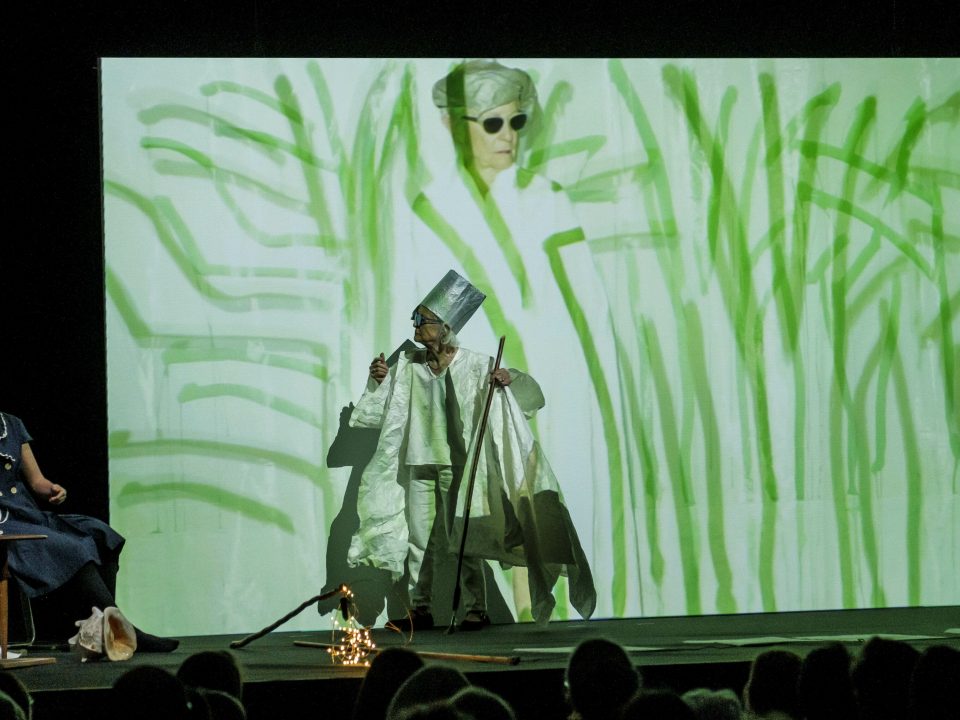The conversation between the artist Joan Jonas, curator and artistic director Andrea Lissoni and curator Julienne Lorz took place on October 13, 2017 at Tate Modern in London. This is a shortened version. The full interview can be found in the exhibition catalog.
Julienne Lorz: Let’s start with Stream or River, Flight or Pattern. It essentially consists of three video projections, and each one is a separate piece in itself: Each was filmed at a different location and at different times that you then brought together for this work. The work seems to represent some kind of a break in your practice, particularly in the way that you are dealing with objects. You hugely reduce the amount of objects in the space. The kites hanging from the ceiling are the only objects in the installation, in comparison to works like Organic Honey [1972/1994], The Juniper Tree [1976/1994], or…
Andrea Lissoni: …or They Come to Us without a Word [2015], which features a considerable amount of props and screens…
Joan Jonas: Well, in Stream or River, Flight or Pattern, there were also fourteen five-foot wooden panels of bird drawings placed around the space, which focused the installation on the subject of birds. When I began in the late 1960s, I used everyday objects that I collected in specific ways. And, just as I developed working with video images—projected or on monitors—I think I just constantly reimagined ways of dealing with objects. As I continued to collect objects, I also made objects. In Stream or River, Flight or Pattern, you’ll see in one video, which was inspired by Vietnam, that many of my objects I’ve collected over the years are piled up in different ways and sometimes carried by performers. The three works are shot in different places on my journeys. Parts of two videos in this work, the bird piece and the Vietnam piece, were finished in my studio as we combined projections of the collected footage from various sources with performance, with myself and some of the performers that I had worked with before in the Venice piece [They Come to Us without a Word]. Relevant objects were chosen to include.
JL: Right.
JJ: About a year ago Filipa Ramos invited me to write a poem for her book concerning animals. So I made a list of my objects that represent animals, thinking of the way we have animals in our lives. But they’re not real, they’re representations. And so I included some of those. The poem is heard as a voiceover in the Vietnam video, where we arrange and carry the animal objects referred to. The poem reads like a slideshow.
JL: And you didn’t feel you wanted to have the actual objects from the videos in the space with the projections?
JJ: That installation was designed for this very large and beautiful space at Gavin Brown’s enterprise. The objects would have been lost in it, but they were included with many props and masks from my collection in the downstairs gallery, so that the audience had a memory or reference before seeing the installation on the top floor. But in recent large-scale installations, while there are objects, I don’t include the smaller objects that I perform with in the performances, knowing that I’m probably going to use them again and again. So there’s a set of objects for Reanimation [2010/2012/2013] and They Come to Us without a Word, for example. And also for Lines in the Sand [2002], I keep these smaller objects in a box somewhere.
JL: It’s a pragmatic reason to a certain extent?
JJ: In a way, yeah. I’d like to include them, but, while not wanting to part with them now, I will someday soon.
JL: The kites become an architectural element in a sense, while, when I look at some of your other works or installations, the objects are part of the overall work, a “Gesamtkunstwerk,” but not so much a structural element.
JJ: Well, kites themselves have beautiful shapes which become part of the overall picture. So I’m not thinking when I choose the kites, “Oh, now I’m going to make an architectural element.” But how and where to hang them is a consideration.
JL: No, sure.
JJ: It’s different. But they just—because they’re a group of large objects—they’re part of the set, the stage set. They help to define the stage set. These kites I collect are very beautiful. Actually I don’t include in my work the kites by the artist in Japan and painted with his designs. They’re simply hanging on my walls. The kites I got in Vietnam define the space as they’re installed high up above the heads of the audience. We changed the color, painted them yellow. Two of the three videos in the piece include birds and the sounds that birds make. I feel the kites refer to birds, in a way. But for my latest show in Reykjavik, they’re exhibited as kites hanging from the ceiling high above the audience in the same room with drawings hung on the walls. Here, the kites don’t depend on an installation. I wouldn’t necessarily show them in this way again.
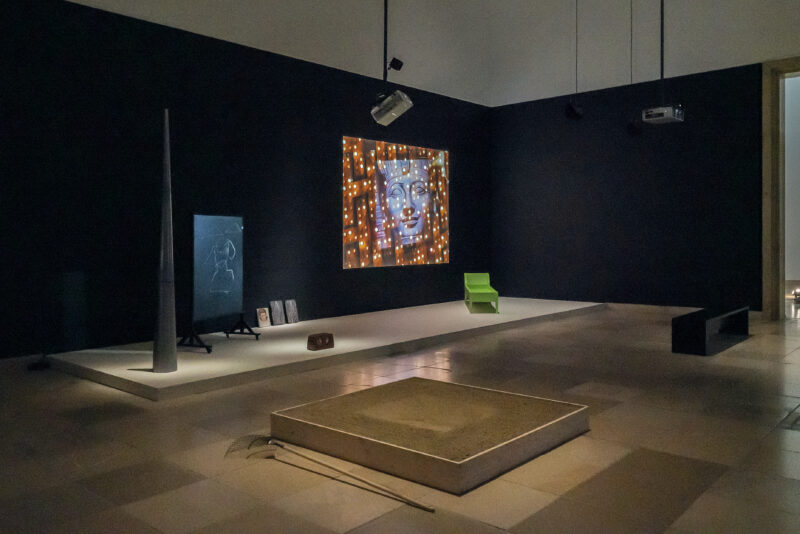
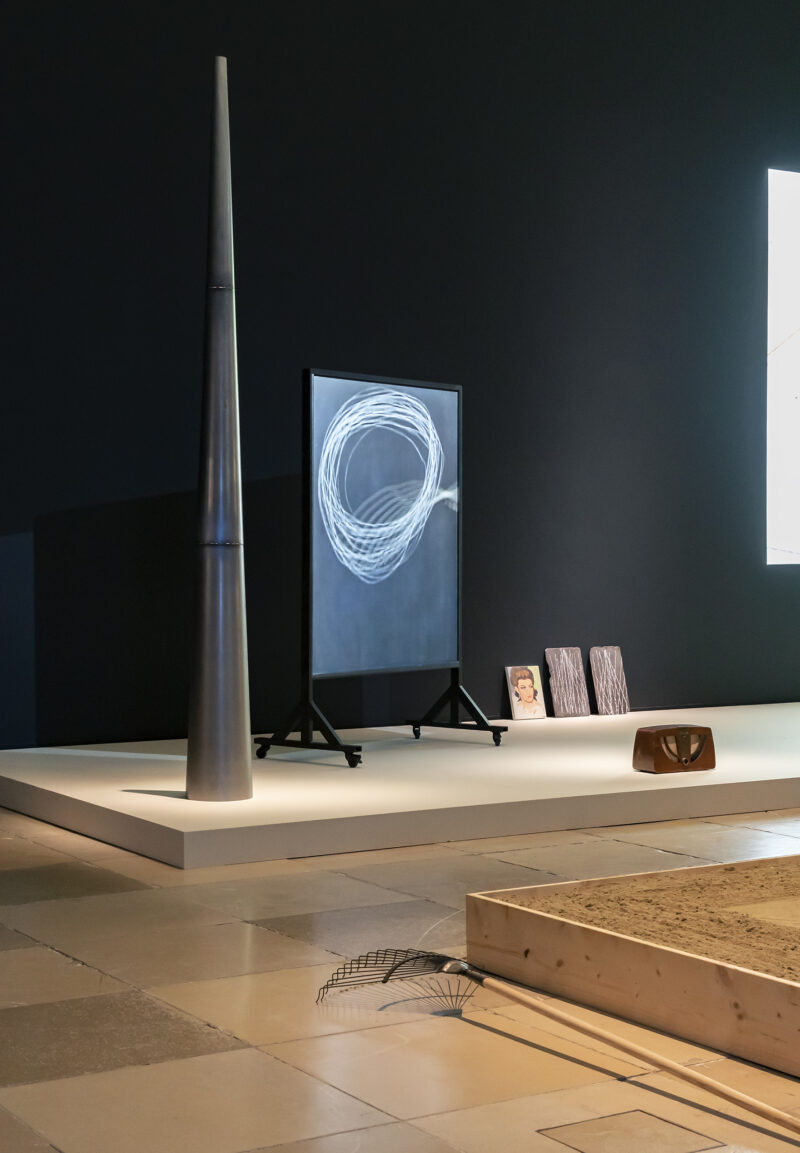
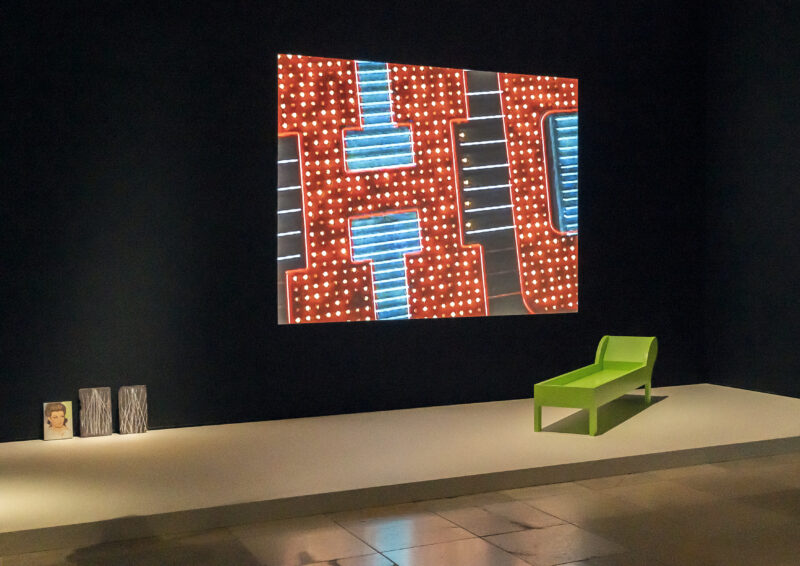
AL: You just used the definition of “stage sets” when describing the work. I was wondering whether you could explain this unusual definition: it’s not an installation, nor an environment. It’s stage sets. Why or when do you define a work of yours as such?
JJ: Well, when I began to think about turning my performances into installations, I had to have a structure for doing that. What is my reason for turning my performances into installations? And how do I think of: What is an installation? It’s an arrangement of things. But what’s your reason for doing it? And I come from a performance and a film context, as well as a study of art history, in which things are framed in a certain way, always framed or contained. I wanted also to link it to my sculpture, my practice of sculpture, before I started doing performances. I consider the situations I set up for the performances to be related to my sculpture. In a way, it was sculpture in an expanded field. When I had that show [Stage Sets, ICA, Philadelphia, 1976], I thought of it this way. And so I looked at my own work and the situations that I made for each performance, which was a kind of stage set that I would step into, and that transformed the relation of my body to the space and the audience. And then I put that literally in—that was the installation. Organic Honey was a frontal performance, as were Lines in the Sand and Mirage [1976]. But, as an installation, it’s a three-dimensional, all encompassing situation. I combined the different versions of Organic Honey, including all the videos that were made in relation to that work, together with the furniture and objects, as well as different set-ups with camera and monitors, all in the same room. The sounds from the videos are percussive in a similar way, with just a few bursts of reggae music. And so the soundscape works as well. Also, at times a work begins as an installation and then becomes a performance.
AL: Indeed.
JJ: I still use objects somewhat similarly to the way I began in Organic Honey.
AL: Well, it is one of the reasons why we insisted on displaying Stage Sets in your exhibition at Tate Modern, Haus der Kunst, and Serralves. There are a many turning points in your career, but in your exhibition history there are at least two moments that stand out: one is definitely in 1994 when, at the Stedelijk Museum in Amsterdam, you “transformed” your performative works into actual installations. The other took place in 1976 at the ICA in Philadelphia when you had your first survey show, titled not by chance “Stage Sets.” It is there that you presented the artwork Stage Sets for the first time, but also The Juniper Tree was commissioned for the show. The exhibition had the ambition to present your entire practice, putting “environments,” performances, films, and videos next to each other.
JJ: There was a double starting point. Suzanne Delehanty, the curator, asked me to do a performance for children. I thought, what am I going to do for children? The idea occurred to me that a fairy tale is one way to imagine a performance for children. Also, until then I had been developing black-and-white video performances and tapes—Mirage was the last one of that series—and I wanted to begin to work with color and narration in a new way, without video. I felt I was becoming dependent on the technology of video. How do you work without video? I had previously made a sculptural stage set for Mirage before the show of “Stage Sets,” which we then used for the first version of The Juniper Tree performance in Philadelphia.
AL: Yes.
JJ: I hadn’t yet made the structure called Stage Sets. But I made it for the Philadelphia show in order to shift a little bit and to involve elements from earlier pieces, like hoop, poles, and paper walls from Funnel [1974], tin cones from Mirage, and chairs from Organic Honey. It’s really based on works that preceded it. Later for The Juniper Tree, I made a new stage set, which is a representation of the so-called house in the story, made of ropes and wood that can be collapsed and pulled up and change shape during the performance. I made that after the Philadelphia show because I did different versions of The Juniper Tree. The one in Philadelphia was the first version with other people performing. There was a second collaborative version for the Kitchen in New York, but I then wanted to do a solo piece because I felt like I was losing a connection to myself in relation to the source, the story. This construction was developed and performed in my loft, and that’s when I started to paint and make the paintings for the backdrop. I’d always drawn in my work, but not painted.
AL: It’s literally the first installation, but it wasn’t called installation yet. The term wasn’t used in art by then, hence you called it Stage Sets. And the title reflects exactly, almost ontologically what the work is.
JL: It’s really a very minimalist installation. And as a viewer, you were meant to walk through it and experience the space that was altered through your elements.
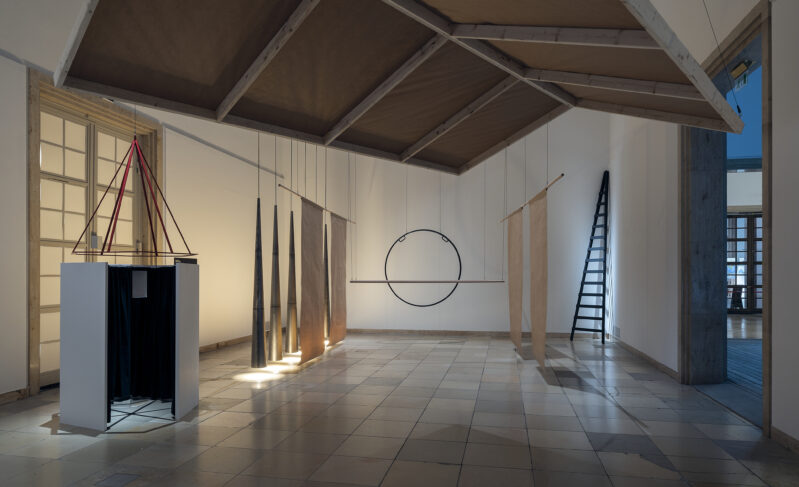
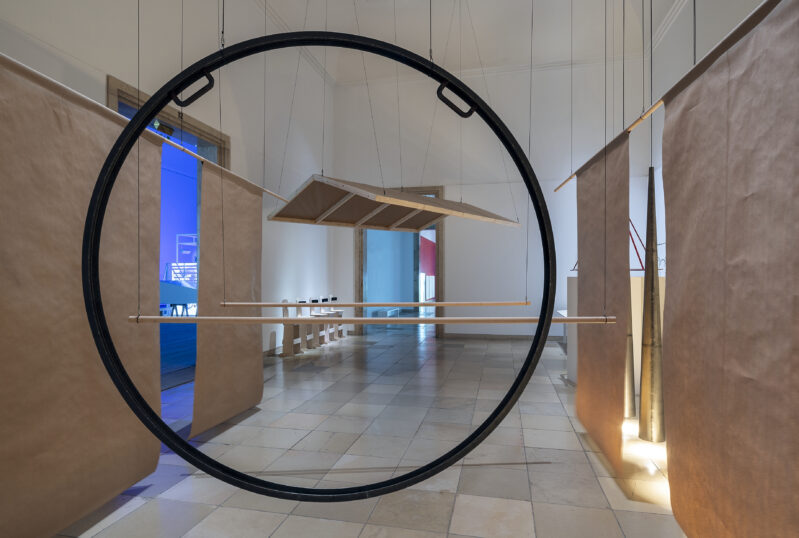
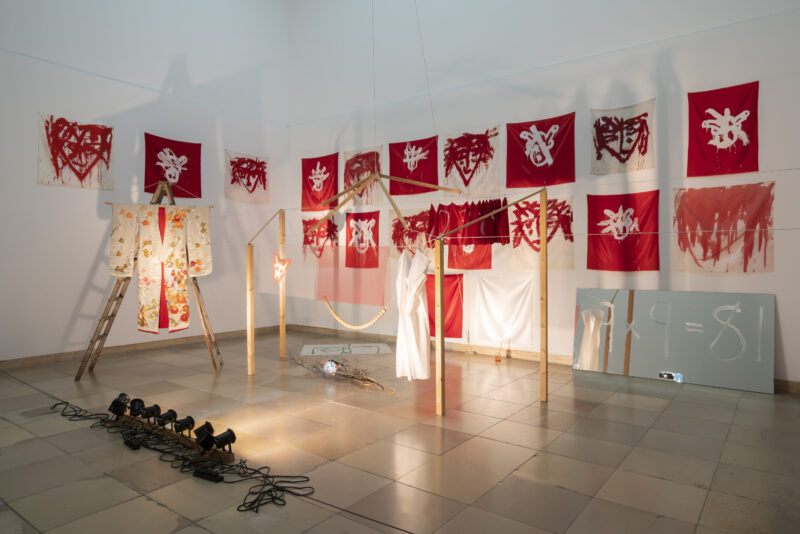
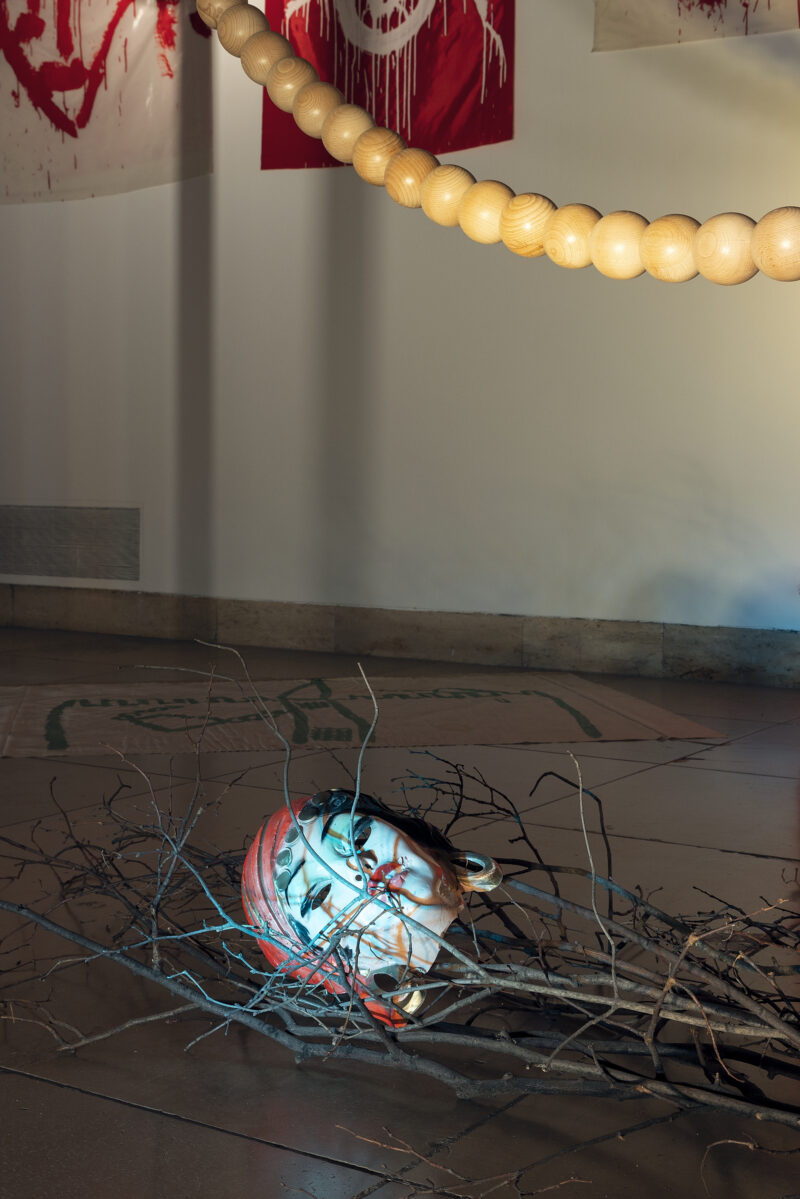
AL: It’s fascinating to note that there isn’t a text at its beginning. In general you’d start from a text. Not necessarily an original, rather recombined texts, outcomes of a cut-up process, texts to be read in a performance…
JJ: Well, I never used text like that until The Juniper Tree, when I started working with fairy tales. But I did use the [Jorge Luis] Borges text for the solo version of the Mirror Piece [1969]. I was inspired by him, and so I read and memorized it, but it wasn’t part of the larger Mirror Pieces until I redid Mirror Piece at the Guggenheim [in 2010].
AL: Is the animals poem in Stream or River, Flight or Pattern the first text of yours that you used in an installation?
JJ: Fragments of my writing are included in Volcano Saga [1985–89], and I Want to Live in the Country [1976], although a video, is entirely my writing in diary form. My latest video, inspired by Vietnam, includes my list of animals collected in poetic form. For a long time I have referenced the book of the Noh drama translated by Ezra Pound and Ernest Fenollosa [The Classic Noh Theatre of Japan, 1959]. For this last work I extracted lines from the Noh plays in the book and arranged them. I’ve been inspired by that book since I visited Japan in 1970, but I never worked with that text until just recently. The lines from the Noh were a sort of inspiration for Stream or River, Flight or Pattern. In the shadow video, made in Santander with participants from the workshop there, one of them, Allison Hamilton, put these verses to music and sang them.
JL: Stream or River, Flight or Pattern brings together different times and places, and seems like it is only completed by the viewer experiencing the work in the here and now. In that sense it feels like a different way of dealing with time than in other pieces or installations, where you’ve maybe made one version, and it’s a finished work. And then you go back to it some years later and do another version of it.
JJ: The reason I go back and make new versions is partly an attempt to make something better. Or to recontextualize certain elements, and in that way alter them, and have them relate to a new work. If I’m not satisfied with a version, I often continue to work on it. But I don’t do this just for the sake of doing it.
JL: Sure.
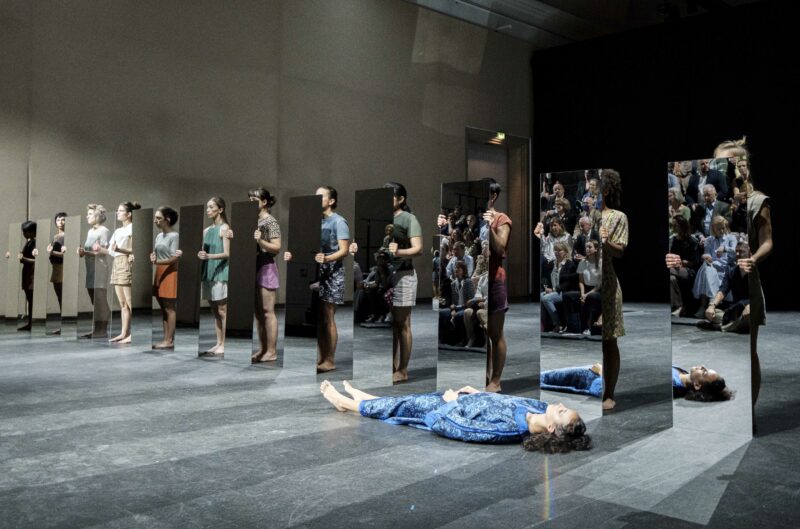
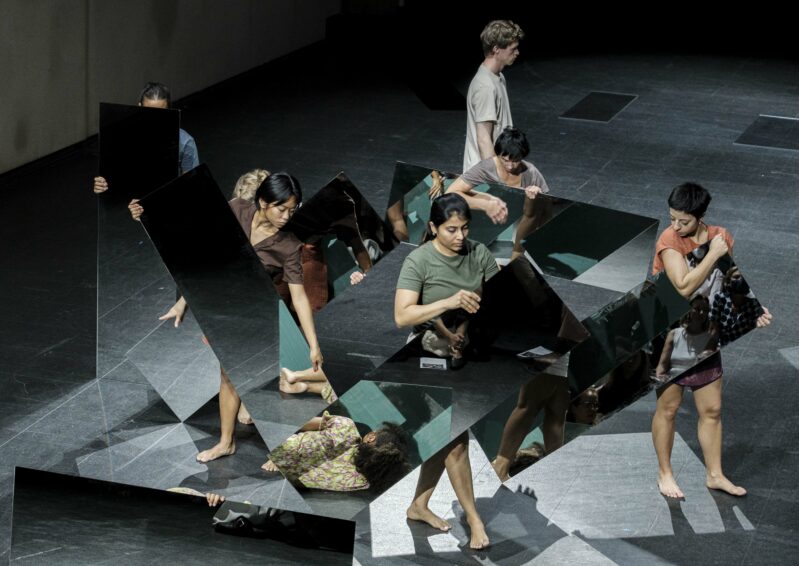
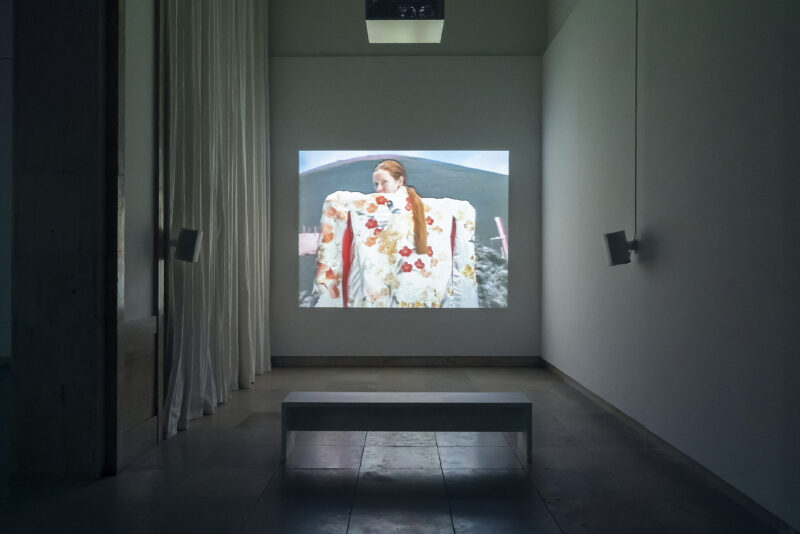
AL: Moving on to the relationship between technology and the actual work, and also to the way in which you depict your subject matters, how are you currently thinking about how an animal sees and how your camera or your editing process try to engage with it? I’m referring in particular to some suggestive moments when it seemed to me you were representing the way a fish can see in your performance Moving Off the Land at Tjarnarbíó, Reykjavík [2017].
JJ: Well, I don’t know yet. But I know a scientist who’s experimenting with how fish see, for instance. I was planning to work with him, but I haven’t had a chance to do that yet. But that’s how this subject came up. And also there have been articles about how fish feel and how they like to be touched and that they get depressed. Things like that. How do fish perceive? To me, that is very interesting. I included descriptions of what I see as miraculous beings, like the octopus. This is a work in progress, an ongoing research.
AL: So you don’t know yet at which point you will be pushing the theatrical-cinematic apparatus you’re working on, when working on a performance?
JJ: I continuously do that. But it’s experimental and one doesn’t always know where improvisation will lead. I have performed Moving Off the Land three times, in Kochi, India, in Vienna, and in Iceland. Each time I alter it, while exploring possibilities.
AL: Where does the title come from?
JJ: A friend of mine, Ann Reynolds, sent me a poem by a Scottish writer. He doesn’t say this phrase, but that’s what came into my mind while listening to him reciting his poem. It just came to me, leaving the land. It’s actually a good title for this. It also is part of the subject matter, like the whales. They came on the land from the sea and then they went back to the sea. I deal with the mythology of the sea. This will be one of my main focuses, because myth is an underlying theme in my work. How does myth begin? It’s a subject; the myth of the sea, the mermaids, they come on the land and then they go back to the sea.
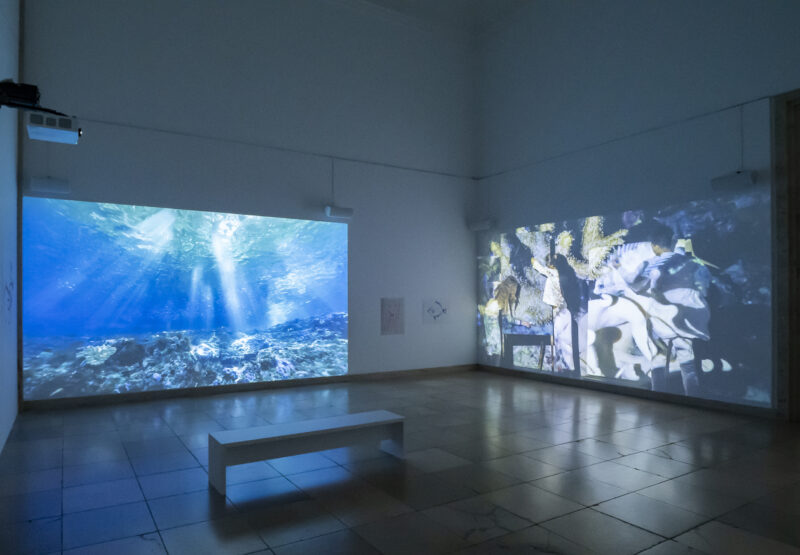
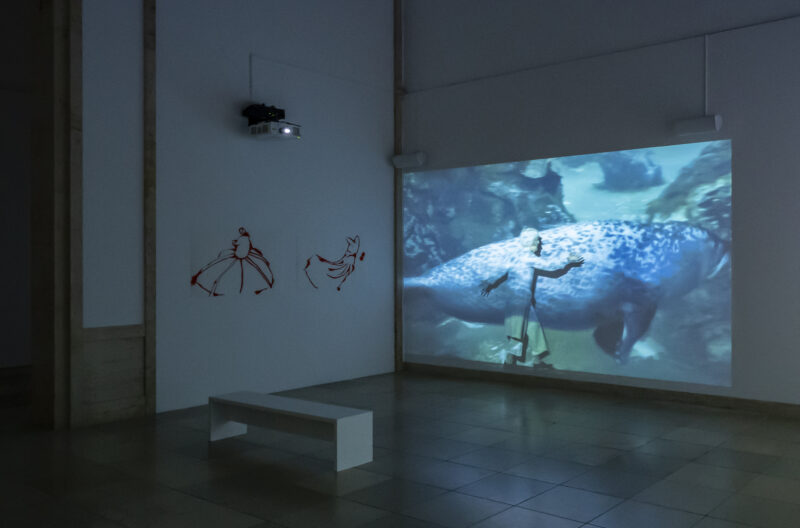
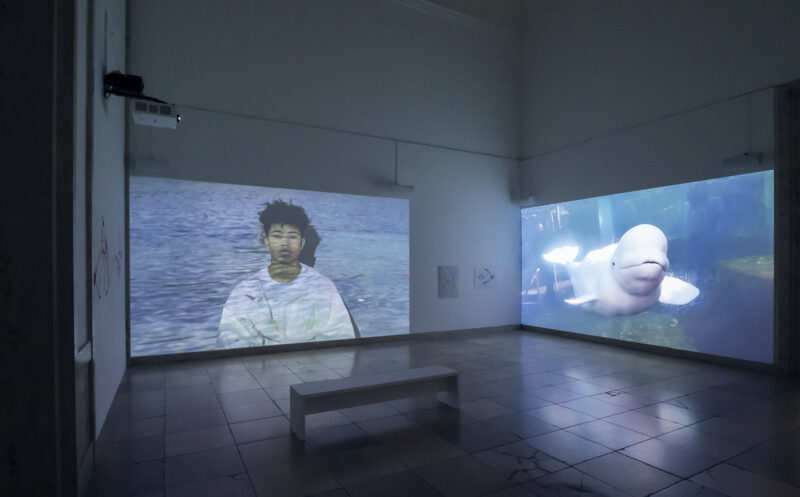
AL: Perhaps this is one of the last questions about Stream or River—it is true that the three videos are very different despite running together very well. What they all share, though, is this presence of streets, tunnels, these paths that you go through—they’re always there and they are often present in your work. In an interview with Ann Reynolds, you mention Paul Sharits in relation to these corridors. And I was wondering why exactly?
JJ: Because he made a film in which the camera is zooming down a corridor, and cutting forward and backwards, fast. But I don’t know why I mentioned it, because I’ve never been influenced by that particular work, although it is great. Michael Snow made Wavelength [1967], also zooming slowly in. It’s a natural thing you do in film and video with a camera, you zoom or you don’t. The camera space is partly about going into the depth, about the illusion of depth, just the way painting is. But for the camera it’s obviously a moving image. You move into the space. I find that very attractive, the shot traveling down the road or into a tunnel.
JL: This idea of going into the camera space is interesting, because one of the main subjects in your work has to do with space. You are constantly negotiating between the media space, the camera space, the viewer space, and the actual space. You explore all these different depths.
JJ: Yeah, because when I started out, it was questions like, what is the space of the performance? What is the space of what you’re recording, the outdoor space? How do you frame it? And then the cut. And the space in the monitor, as well as the monitor itself as it sits in the space of the room. This is reflected in the glass of the monitor in Glass Puzzle [1974/2000]. The space exists on different levels: camera space, this actual space, and how you make the illusion of space.
JL: Right. And then with that, the factor of time as well: some of it is recorded, some of it is actual. You bring out these different levels of perception for the viewer.
JJ: Yeah. People always ask me about time. Time is part of it. It’s not something I conceptualize. I deal with space in a very physical and a conscious way. In video and film and performance, time accompanies that. How long to move from here to there? How long does it last? Give it time. Flash an image—a memory. I work with time, but I don’t plan ahead of time. I juxtapose different times, curious about how they’re going to affect each other.
AL: To stick to space, you began using the grid as a device recently. It is very visible presence, something one would perceive when passing in front of a screen, like in Reanimation or in Double Lunar Rabbits [2010], potentially casting a shadow on it. Is there a particular reason for you to start using the grid?
JJ: I started with the idea, “I want to make a screen based on the Japanese houses with this grid structure.” And then I saw the effect afterwards.
AL: I’m using the term “grid” keeping in mind what Rosalind Krauss wrote about the grid as a figure to rethink the role of time in late modernist sculpture, opening up sculpture to performance.
JJ: Well, you could say that, because I’m interested in constructing structures or places for the video. So I was glad when Carolyn [Christov-Bakargiev] asked me to do that piece in the garden, in a prefabricated house, instead of the gallery spaces of documenta [13, 2012]. I don’t think it was entirely successful in the house. The idea or concept of working with this small house was that people would have to look at the video and set through the windows, and not enter the house. The videos of Reanimation at that time were the same as they are now. While I liked the idea of not being able to enter the house, I don’t think it worked well. It wasn’t the best way to look at the videos. So then I wanted to make a different house structure that you would enter, and see the work from the inside. The free-standing screens of Double Lunar Rabbits and, later, Reanimation, had back projections, because I wanted the audience to walk around as well as inside these enclosures. I also didn’t want the audience to cast shadows. I made Double Lunar Rabbits first with these paper and wood screens. I got that idea from being in Japan, working with the CCA in Kitakyushu. I thought to design curved screens as a way to display Double Lunar Rabbits, working with the idea of the sho–ji, the house. What interested me in this case was the fact that the curves, from certain angles, continuously cut off parts of the images as one moved around the space. Later such screens were designed for Reanimation.

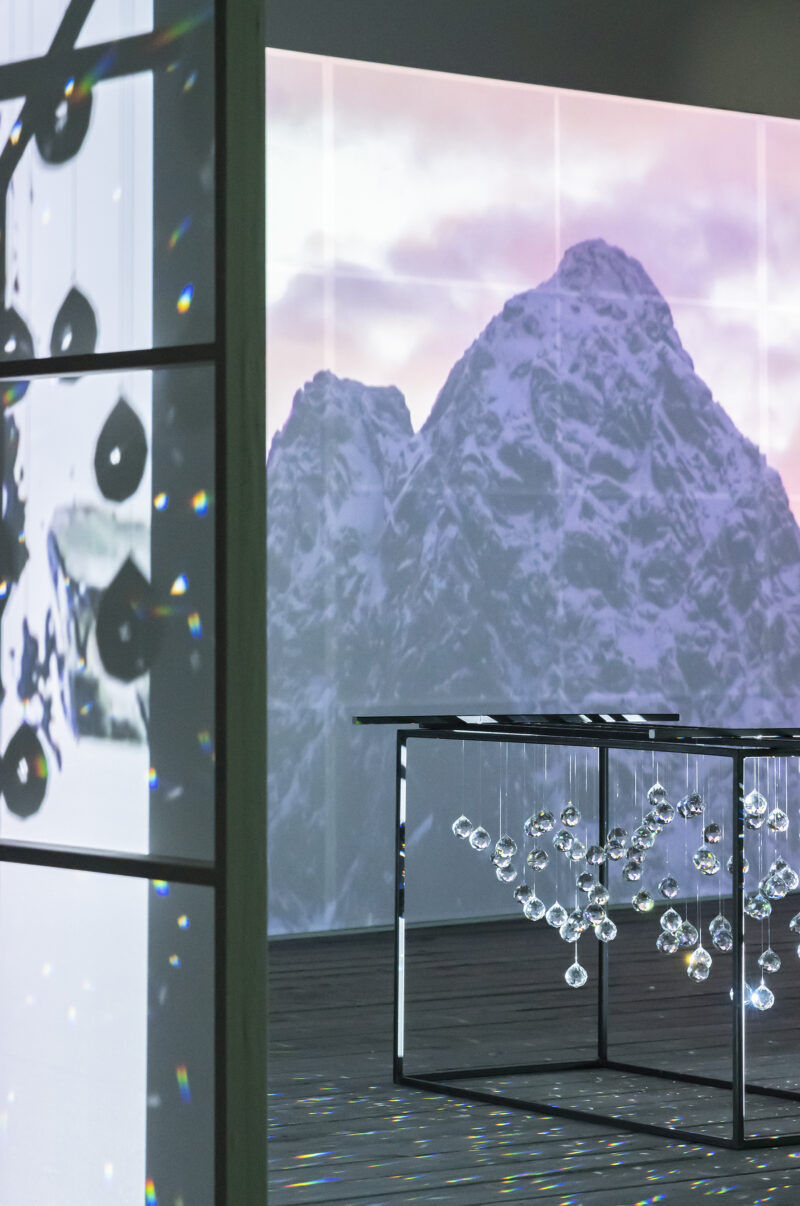
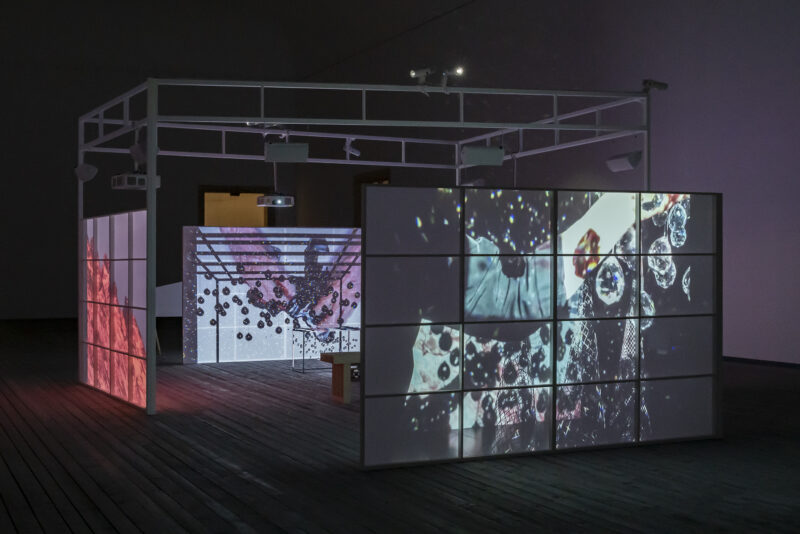
AL: One could walk through your show and see how your relationship to media has changed: inventing screens, inventing formats, and how your way of shooting, editing, engaging with moving images in general has changed throughout time. But something that is always there, and it’s very typical of you, is the voice and the way you use the voice. Did you have any training? How did you start working with your voice? And how do you feel, continuing to use your voice throughout so many years in that precise and very specific way?
JJ: I didn’t start out using my voice in my early work because I didn’t feel comfortable and I didn’t have a reason. I didn’t use text in that way. Maybe a few words here and there. I didn’t train formally. I trained myself. I recorded myself, listened to it, corrected it, recorded myself again. I did that for quite a while as I began to use my voice. And then, when I started using fairytales and narrating more complicated stories, I could hear if my voice was working or not working. When I worked with the Wooster Group, that was another context for speaking lines. That’s maybe one of the reasons that I played Masha in Three Sisters. I did that partly because I wanted to experience memorizing lines, saying them and working with my voice. And yes, I continue because it’s one of the things I have. It’s one of my tools. So I’m interested in using it. It’s hard, though. It’s gotten raspy … but before the performance in Iceland, I went and ate a lot of butter. And that helped.
JL: Really?
JJ: It does. It helps your throat. I was going to study voice with La Monte Young in New York. I went to the first meeting and he and Marian [Zazeela] told me I had to eat a quarter of a pound of butter a day to work with them, and so I quit right then. It would’ve been interesting to study with him, but not to eat a quarter pound of butter. But that’s what Indians do. It coats your throat.
AL: But you very rarely, or never, sing.
JJ: I used to sing. In all my early work I’m singing. Or barking. Or howling. I’ve sometimes thought of using my voice again like that, but I haven’t for quite a while. But I can’t sing anymore. My voice cracks. It’s old age.
AL: There is a sentence—I cannot recall where I read it—where you say that you started howling and you became the dog. Am I wrong?
JJ: No, I said that. I’m sure.
AL: The intention was to transform, once again, your status through the act of barking.
JJ: Right.
AL: Why do you actually howl at the end of…
JJ: Well, I howl at the end of Organic Honey. Because one of the other things I was reading at the time was Djuna Barnes’ book Nightwood [1936], where she becomes like a dog and howls. So that affected me. And then I became a dog in the piece.
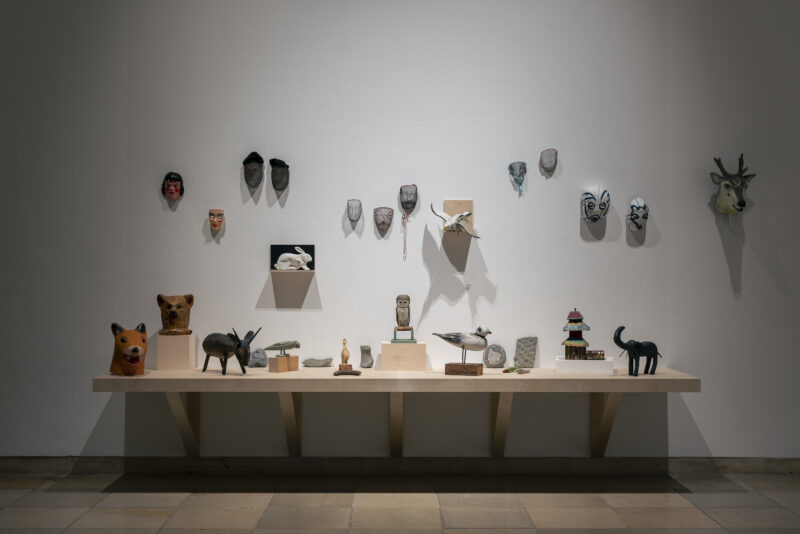
Artist info
Joan Jonas
Joan Jonas (*1936 in New York, USA) hat das Verständnis und die Geschichte von Performance und Video nachhaltig beeinflusst. Ihr konstantes Experimentieren mit den interdisziplinären Möglichkeiten von Kunst hat sie zu einem zentralen Bezugspunkt für nachkommende Generationen an Künstler*innen gemacht. Jonas studierte am Mount Holyoke College in South Hadley, Massachusetts und erhielt einen MFA in Skulptur an der Columbia University in New York. Ihre Arbeiten wurden international ausgestellt, zuletzt in Einzelausstellungen in der Dia Art Foundation (2021); dem Thyssen-Bornemisza Museo Nacional, Madrid (2021); der Pinacoteca do Estado de São Paulo, São Paulo, Brasilien (2020), dem Ocean Space, Thyssen-Bornemisza Art 21, Venedig (2019); der Tate Modern, London (2018); Fundação de Serralves, Porto, Portugal (2019). 2015 repräsentierte Jonas die Vereinigten Staaten auf der 56. Biennale von Venedig und 2018 wurde sie mit dem Kyoto-Preis ausgezeichnet. Jonas ist emeritierte Professorin am Massachusetts Institute of Technology in Cambridge.
